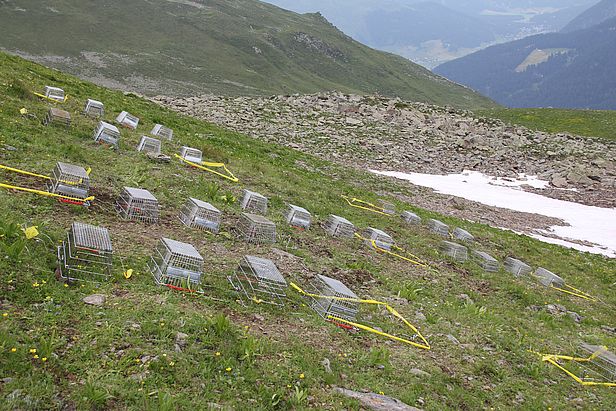Shifts in the treeline depend not just on temperature, but also on other factors. Researchers from the Swiss Federal Institute for Forest, Snow and Landscape Research (WSL) and its Institute for Snow and Avalanche Research (SLF) investigated this.
As a result of global warming, the treeline is already shifting to higher elevations and towards the poles. But until now the extent of this shift was unclear, as was the speed with which it will take place. One important question in this context is whether or not - and if so under what conditions - tree seeds can germinate and thrive above the current treeline.
This is what researchers from WSL and SLF investigated in a seedling experiment, which involved sowing larch and spruce seeds at three different altitudes on the Stillberg research site near Davos: on the natural treeline at an altitude of about 2,100 metres, 150 m below that and 300 m above it. The researchers compared how many seeds germinated in each altitude zone and how many seedlings survived the first two winters. They also investigated how seed availability, competition from other plants and other factors affected germination success.
Seed availability and competition from vegetation are decisive
The researchers were surprised by their finding that seeds germinated better overall at the highest elevation (2,400 m), than at lower altitudes. This shows that trees can also germinate well above the treeline. However, this result was only observed in the sown seeds. They found no trees that had grown naturally in the control plots. According to the researchers, the reason for this is that there are no germinable seeds there. After all, trees on the treeline produce only small numbers of poor quality seeds, because the climate at that elevation is unfavourable.
Unlike at the highest elevation studied, dense vegetation on the treeline prevented germination, with spruce and larch only sprouting in significant numbers in places where the researchers had removed the vegetation before sowing. This shows that competition from dwarf shrubs such as alpine roses and other ground-covering vegetation makes it much harder for tree seeds to germinate. In all altitude zones, additional factors such as seed source or herbivory also influenced germination success.
Survival only in optimal conditions
But even if seeds germinate successfully, the winters take a heavy toll on the young trees, especially those above the treeline, where only around 2% of seedlings were still alive after two years, compared to about 40% on the treeline. Furthermore, the saplings above the treeline remained much smaller than those growing on the treeline. "This suggests that young trees growing above the treeline can only survive in the long term if conditions are optimal", says WSL researcher Esther Frei.
The researchers' study, which was conducted together with Canadian colleagues, was recently published in the journal Scientific Reports. The researchers now plan to combine their findings with those from other locations on alpine and polar treelines. The experiment at Stillberg is part of the coordinated Global Treeline Range Expansion Experiment, or G-TREE initiative, in which similar seedling trials have been conducted at some 15 sites worldwide since 2013. The aim of this research is to determine the influence of various factors on the advancement of the respective treelines.
Contact ¶
Links and documents ¶
Original publication:
Frei, E.R., Bianchi, E., Bernareggi, G., Bebi, P., Dawes, M.A., Brown, C.D., … Rixen, C. (2018). Biotic and abiotic drivers of tree seedling recruitment across an alpine treeline ecotone. Scientific Reports, 8, 10894 (12 pp.).
Project webpage G-TREE
Copyright ¶
WSL and SLF provide image and sound material free of charge for use in the context of press contributions in connection with this media release. The transfer of this material to image, sound and/or video databases and the sale of the material by third parties are not permitted.



